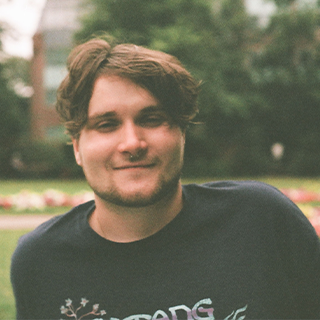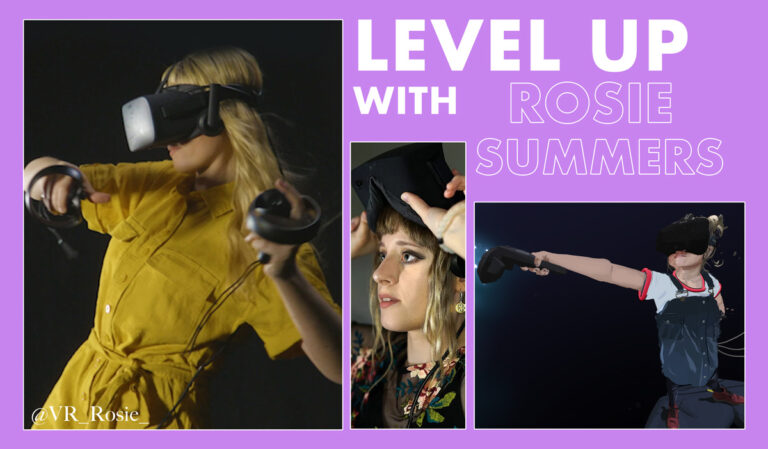VR artist Rosie Summers on successfully bringing creativity into a new dimension
Sculpting to painting, drawing to design—what do all of these art forms have in common? They’re limited by external, natural forces, be that something as mundane as running out of paint or as rigid as gravity. But what if I told you there was a truly immersive form of art that transcends our worldly limitations? A technology that allows full, untouched creativity—where you can not only manifest your own creations but let people actually live in the artwork you’ve made. That’s where VR art comes in. We spoke to Rosie Summers, a 3D animator at XR Games as well as a VR artist and performer in order to find out more on how she unlocks her own creativity in a completely new dimension. She’s already worked on major titles—Angry Birds and Zombieland, to name a few—and continues to use VR art to help bring her creative concepts into the gaming world. She told Screen Shot Pro, “I work as an animator, mainly on bringing digital characters to life in fun, innovative ways using virtual reality technology.” Here are some tips the pro had to share.
Although a self-proclaimed lover of gaming, animation and art, it wasn’t until 2016 that Summers discovered the incredibly creative opportunities VR can bring to the table. Before that, she enrolled in a BA in Animation at Leeds Arts University. She had tried VR previously using the Oculus Rift, in particular a demo where you could observe a fountain in Tuscany. “It was really exciting but I could see there was a lot of growth to come. I had motion sickness and all that kind of stuff,” she said.
But then she discovered the Google Cardboard. “For me, that was the pivotal moment where I realised the amazing capabilities of VR. It really made sense to me. It was a wild moment. I was just using my phone and a piece of cardboard, I was transported through my phone into a different world. I remember looking down and seeing flowers grow by my feet. It was a magical moment where I realised, as an animator and storyteller, I could put people inside my stories—that’s a really exciting concept to me.”
“Then I saw a video of a famous Disney animator, called Glen Keane, using VR. And that, to any artist, to see someone famous inside this new world, painting characters to scale and the space around them, was absolutely mind-blowing. That was the moment where I told myself ‘yeah, I’m buying this’ and the next day my headset arrived. That was when my journey began.”
Voir cette publication sur Instagram
A revolutionary, innovative form of creativity
“VR allows you to go inside the world at large to see things from a first-person perspective,” Summers told us. “It gives you an idea of how you feel in the virtual space. The atmosphere, the colour schemes, how to best place assets in the scene.” It’s for this reason that VR artistry has pricked the ears of the multimillion-dollar film industry, with companies like Disney using VR art in their concept design process.
But VR artistry isn’t strictly pinned down by concept art and design. Of course, it is an invaluable asset to any company that wishes to plan and design a truly immersive concept—but the creative possibilities of making art in, quite literally, another world are endless. Summers highlighted how “it’s a completely new medium. Your brush strokes defy gravity—your paint is suspended in the air.”
“When you are painting, your whole body dictates the strokes and how you’re applying them—it’s a revolutionary concept for any artist to paint the space around them.” Summers went on to describe how VR art can, in some ways, be compared to traditional sculpting—carving out creations in a 3D space. Yet, unlike sculpting, VR artistry is not confined to physical limits like gravity—unearthing endless possibilities where, quite literally, the mind is the limit.
VR art and interpretive dance
Summers soon caught on that the limitless capabilities of VR creativity can be combined with other forms of art. Summers’ signature style being “interpretive dance.” For the artist, VR art “opens itself up to new, organic ways of working. I soon realised that when I was painting, it almost became like an interpretive dance. I really played with that and realised how much fun it was to perform in front of a live audience.”
“I really enjoy that [aspect of VR] because you can just get lost inside your artwork. It sort of taps into the creative part of the brain when you’re put in a virtual space. There are no external distractions so it lends itself really well to getting lost and experimenting,” she added.
Summers has performed in her interpretive dance and VR artwork shows at events across the country, like LightNight Liverpool—which was completely improvised, making her work interactive with a live audience—and at the British Library in a live painting show celebrating women authors. Now, due to COVID-19, she’s had to adapt and hosts online “virtual performances on webinars where people can just hop on whenever they want and watch me in a little window, dancing away inside this virtual world, painting.”
The therapeutic value of VR art during a pandemic
The COVID-19 pandemic has hit everyone hard, especially the creative industry. After losing a number of clients during 2020, Summers found refuge in VR art—a place where she could escape in her own digital paintings, creating a safe space sheltered from the unstable world. She said, “Because a lot of the events I was booked for were physical, I lost a lot of clients during that time. I would paint safe, serene scenes to escape and experience the reality that I obviously couldn’t at that point in time. The painting in VR was therapeutic, it really had a huge effect on my mood. The emissivity of everything—it just feels a lot more when you’re encompassed in the virtual world you’ve created. That’s what I spent most of my time doing, sketches to escape. I also did a lot of VR gaming, including VR fitness—it was a really important way [to maintain good mental health].”
Voir cette publication sur Instagram
How do you get into VR art?
It all sounds appealing, right? So, how do you make the switch from paintbrush to Tilt Brush? And if you’re set on becoming the next Leonardo da Vinci in the digital realm, what hurdles will you have to overcome? In short: the price. Summers noted that setting up a VR rig powerful enough to cater to your artistic needs will set you back “around, or just under a grand (£1000).” She continued, “The headset costs around £300 and a powerful graphics card costs around £600. [The price of] graphics cards have gone up massively recently because of the mass shortage of silicon.”
That being said, aside from the price, Summers highlighted how the barrier for entry for an individual looking to start their VR art journey is often misunderstood and overexaggerated. Contrary to belief, very little technical knowledge is actually required for someone to dip their toes into the VR world. She explained, “I think the thing that scares most people is that they think that they have to know coding and programming—that it’s too technology-superior to consider, which is a lie.”
In fact, the transition to the virtual canvas is easier, and more natural, than it first appears. “I’m an artist at heart,” Summers continued, “and that’s what I’ve always been, so it’s accessible to get into VR programmes.” She went on to explain how creating virtual art through controllers like Tilt Brush is actually more intuitive than other forms of creative digital media. The VR medium is unlike other “3D programmes, which are created with the mouse and keyboard and often get a lot more convoluted than they really should be. But [in Tilt Brush] when you’re faced with things like space and movement, things are more natural.”
“The full computing power needed is quite a cost to start with. But think about how much you’d be spending on canvases and other equipment as a traditional artist. The initial investment you’d make would be the equivalent to maybe a year’s worth of art equipment, even less if you go through a lot. Whereas once you have the initial VR kit, there’s hardly any additional costs on top of that,” she continued.
So, if you’re willing to commit to the initial investment, the biggest tip Summer gives anyone starting VR is to “get experimenting, get playing.” Essentially, have fun and let your creative juices flow as you get familiar with the innovative technology. If you’re unable to afford the initial costs, Summer advised to “have a look around for VR meetups and get hands-on with the equipment to see if it’s really for you. None of us are experts, we’re all just testing and playing, finding out what works and what doesn’t. That’s really exciting and fun.”
She continued by highlighting how much the industry has evolved in the last five years. Just half a decade ago, the VR community was very small with meetups few and far between. She had to adapt and experiment at her own pace, whereas now, as VR is picking up in popularity and seeping into the consumer market, there is a wealth of online and in-person support. She said, “When I started, there were no tutorials and nothing telling me what to do or how to work the device. I think that was a bad and good thing, it allowed me to play around at my own pace and that’s what was really important for me. It was about finding my own creative voice in this world—with VR that’s especially exciting.”






